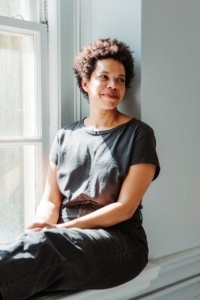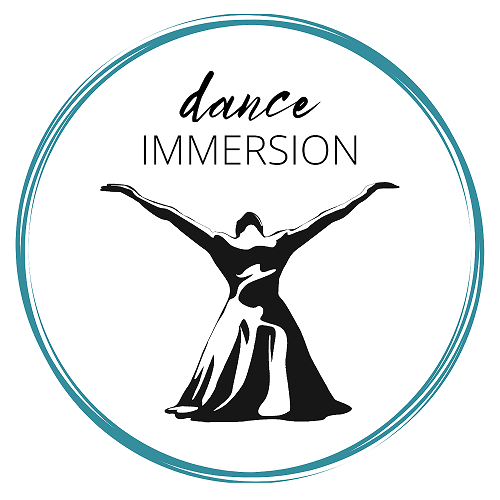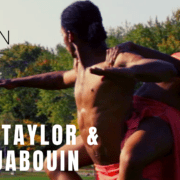
As part of our 2018 Doing Our Thing event, dance Immersion had the opportunity to ask Dr. Seika Boye:
How do you balance being both a scholar and an artist?
Seika’s In-Depth Reply:
“I am not sure that I ever tried to find a balance between these two so often separated categories – scholar and artist – or I did and failed because I thought that they were separate. In truth, the mechanisms to receive support and employment in the fields of scholarship and artistic practice are often separate and this is extremely difficult for many people. It forces them to create separate identities. In me as a person they are entirely connected. I am grateful to be in place where there is room for both – in fact where both are required of me.
I used to joke that I have tried to quit dancing a hundred times but kept coming back. The truth is that I have been oscillating between dance(ing) and writing (let’s say for simplicity’s sake) for stretches of weeks, months … sometimes years, since I was a young person. I was often either in constant motion dancing or sitting and reading and eventually writing. My undergraduate degree is a BFA in Dance with a double major in English (literary theory). I left performing so I could write. When I write it is most often about dancing. You see the pattern.
I stopped training intensively or regularly as a dancer nearly thirteen years ago (when I was thirty) which seems just impossible but it is true. I made a very clear decision to stop performing and to pursue writing and research and for a time I continued to make dances while doing an MA, working in archives, publishing, administration and arts journalism. When I began my PhD in 2010 my oldest son was 2.5 years old and in 2012 my youngest son was born. My time and energy considerations revolve around my family. This is another area in which the idea of balance is not necessarily the most productive for me.
One of the reasons I decided to do a PhD was because I wanted to do in-depth, long term, writing and research which of course requires an in-depth reading practice as well. There was a point at which I clearly saw that in order for me to do the PhD the way I wanted to – which was archive, research and writing focused – I would have to say no to everything else that came my way, and I am glad that I did even though it was not always easy. I trained as a dancer from the time I was three years old – ballet, jazz, tap, musical theatre and then modern and post-modern pre-professionally and professionally. My life was devoted to dancing. Through dancing I understand the value of practice, discipline, study, repetition (I love repetition) but also of improvisation, time, space and community. I needed the time and space in my life, my mind, my body to do the research I was doing — to carry around and then communicate the massive accumulation of knowledge and material I was processing and generating. I needed to be a in a community that could support this work and where I could learn new practices and ways of thinking. In addition to having the privilege to do a PhD, I received a funding award as a Social Sciences and Humanities Research Council of Canada Doctoral Fellow, which also afforded me extra time for a couple of years as I did not have to work (as much) as a teaching or research assistant in exchange for my funding (which is the arrangement in many doctoral programs). Any way you do it, a PhD is an exercise in intellectual stamina and is extremely demanding and stressful physically, financially and emotionally. It is not a sustainable way of living. I learned to think about how things needed to be shifted around rather than about how to find balance because I was not in a balanced environment. I resisted taking on the idea that I was.
I am trying desperately to see my friends more often now that the PhD is done. I walk more – I am a walker and I miss it if I am not walking longer distances regularly. If I see a workshop that interests me I actually try to go. These are shifts in the way I spend my time. I have always had boundaries that allow for down time alone together with my family.
Two other things were happening between 2010-2017 while I was doing my PhD and raising my kids with my husband Logan.
The first was the opportunity to teach movement to actors within the Centre for Drama, Theatre and Performance Studies, which I continue to do. Transferring my movement knowledge into this training context over the past five years and counting continues to be a deeply rewarding experience in which I get to question, consider, work with and learn from moving bodies in a multiplicity of ways. Which also means that I am thinking about community relationships through movement and breath and space. Here again my students and I are often breaking down the binary of text and movement as well as the idea that their practice and their scholarship are, should be, or need to be separate. I encourage critical thinking in all aspects of performance practice. I also teach these students in so called lecture or seminar contexts. It is good for them to meet with me and see me and engage with me in both spaces. When we see someone do something it gives us an opening to see ourselves do it. I’m a dancer and artist and I have a PhD. Big deal. One does not eliminate the other.
The second was the emerging realization that the space I gave myself for research through stepping away from dancing as I had always known it, allowed the way that dance resides in my body and life to transform and re-situate itself. Dance is no longer tied to the complexities of a ‘career in dance’ that negatively impacted the way I felt about dancing for a long time – which was a sorrowful experience. I didn’t feel that there was room for me to grow in the ways that were of interest to me so I had to change course. Now dance is tied to the knowledge and communities I have gained throughout a lifetime of dancing and moving and learning and teaching with others. I have a new-found respect for this knowledge and gratitude for these communities that is bringing me a lot of joy.
The question I ask myself now is, “What do I need to do to process the question(s) before me?” Read something? Move around? Write something? Walk outdoors? Take a workshop or a class? Have a conversation? Teach about or around it? Ask my kids what they think? Head to an archive? See a show? I don’t defer to an external perception of what balance might be. I think I only actually understand balance as an embodied experience anyways or as something achieved with material items in space (as in children’s blocks). Even if I say I am going to spend an hour doing x and an hour doing y, it does not actually mean any balancing went on in terms of processing ideas. By recognizing the questions that emerge within me and being open to any of the multitude of knowledges that I have as a dancer, cultural historian, educator, writer, employee, sister, daughter, friend, mother, mixed-heritage Black woman, and wife I am not trying to force any one thing to the forefront. Sometimes I think that what taught me the most about how to ‘deal with things and people’ was working in the service industry from the time I was fourteen to the time I was nearly twenty-eight or nine. I have always had to work – to help pay for dance lessons and tuition not to mention the cost of living once I left home at twenty.
Something that I know from my dance training and that I teach all the time is that you cannot force balance – it is a dynamic state that requires constant adjustment based on the arrangement of the matter that is trying to achieve balance.
One of the biggest challenges before me right now is administrative. Now that I have opened my life back up to freelance work outside of my part-time appointment at the University of Toronto, administration has become very difficult – overwhelming. Because I am a scholar/writer, I am often asked to write a few words about this or that outside of the work that I have actually been engaged in a contract to do – if I am in a contract at all – sometimes it is just a request for a few thoughts or ideas. Most times it is not as simple as this or that. The fewer the words, the clearer the ideas have to be (another point I teach all of the time!). Most often this is a process that requires a lot of time and energy for me. In the end, I am usually grateful for the opportunity to have thought something through – writing is thinking for me – but I have to start saying no because I fear that the challenge is becoming an obstacle to the questions that I feel are most important, to me, right now.”
———
Thank-you dance Immersion for this opportunity to reflect on my practices and to teach a workshop at Doing’ Our Thing 2018 with d’bi Young. I am so grateful for the work that the organization has been doing for decades and continues to do.
S.B.
Photo of Seika by Alyson Hardwick: https://www.alysonhardwick.com/about
OFFICE HOURS
Monday to Friday: 10 AM – 5 PM
We are best reached via email:
info @ danceimmersion.ca
CONTACT
DONATE
Every dollar of a donation made to dance Immersion directly supports artists for presentations, workshops, and residencies.


